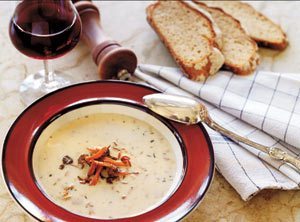Honor the senses, intuition, and pleasure in your diet plan.  At the athletic club, two 30-ish women discuss their diets and bemoan their lack of success. Listening in, I learn they both exercise three to four hours a day; their preschool children fuss about spending all their play time in the club's child care center. Both women are on starvation diets, less than 1,200-1,500 calories a day. One comments that she simply can't stand to continue taking activated charcoal tabs to help block calorie absorption.
At the athletic club, two 30-ish women discuss their diets and bemoan their lack of success. Listening in, I learn they both exercise three to four hours a day; their preschool children fuss about spending all their play time in the club's child care center. Both women are on starvation diets, less than 1,200-1,500 calories a day. One comments that she simply can't stand to continue taking activated charcoal tabs to help block calorie absorption.
I ponder on this insanity. All their anxious vigilance isn't helping them reach their ideal size. At a speaking engagement I recently presented for another fitness center, all the women in my audience were eating only 600 calories a day while doing five (yes, five) hours of rigorous exercise. They complained they were getting pudgier and gaining weight. Yes, logic (a left-brain skill) suggests they would lose weight on this regime. But they weren't.
What's present in both these examples is ample stress, plus logic, analysis and reason. What's missing is sense, flow, love, pleasure and listening to the body's senses.
So let's add them in and take out a big portion of stress. Your body already knows instinctively how to eat, when to eat, how much to eat, and when to stop eating. These are right-brain sensory skills.
By tuning in to how your stomach feels, you sense if it's hungry-it gives you a hunger pang. Intense pangs means it's time to eat, slight pangs means you can wait a while before eating. No hunger pangs means it's not time to eat. Your body knows that the only time to eat is when your stomach is hungry.
Again, by listening to your stomach, you can sense when it's time to stop eating-your hunger pangs cease and your stomach feels comfortable. Stop eating before you feel full, while you can still take deep breaths.
To honor all your senses when you eat, eat slowly so you can savor the tastes, textures, aromas, visual presentation and colors of your foods. For optimal pleasure, eat in a beautiful environment with few or no distractions, loud noises or challenging conversations. Eat when you're relaxed. Yes, I know we all sometimes grab lunch while doing email, but as often as you can, eat beautifully.
Using all your senses, notice how the different types of food feel before, during, and after eating them. For example, I love chocolate cake. It looks good. It tastes fabulous. I love the texture of the creamy, buttery icing. But within 15 minutes of eating it, I don't feel so great. My insides seem to want to crawl out. Chocolate cake doesn't feel great after eating it. So I've experimented with how much I can eat and not have the bad feeling after-about as much as two small cookies. (Yes, desserts last a long time in our home.) Experiment with your "special beloved" foods, listen carefully to your body before, during, and after eating, and you'll discover what your body likes and just how much it likes. Then honor your body's knowing-a right-brain experience.
Other experiences that indicate your body doesn't like a food or beverage are insomnia, crankiness, indigestion, feeling hung over in the morning, rashes and allergic reactions.
When the right brain is in the flow of eating, you don't want to block the pleasure and return to your old left-brain way of eating. Eating with your whole brain-incorporating logic and reason with sensing, pleasure, and intuition-will turn your eating into an art form, make your body healthier and thinner and ease your mind into being more soothed and happier.
Lucy Beale is a corporate wellness trainer and author of six books on wellness. www.Lucybeale.com
